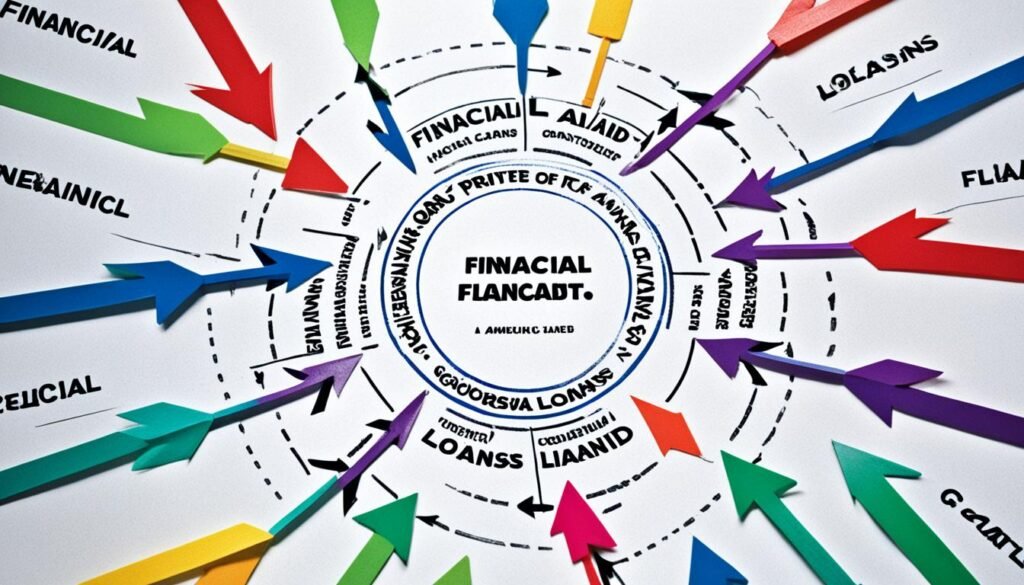Student loans can be a complex and overwhelming aspect of pursuing higher education. With various options available, it is crucial to have a thorough understanding of how student loans work and how to navigate the maze of terms and choices.
When it comes to student loans, there are two primary categories: federal student loans and private student loans. Federal student loans are backed by the government, while private student loans are provided by private lenders such as banks or credit unions. Each type of loan comes with its own set of terms, interest rates, and repayment options.
Repayment is a critical aspect of student loans. It’s important to understand the different repayment plans available, which can include income-driven repayment, standard repayment, or graduated repayment. Additionally, loan forgiveness programs may be available for those who qualify, providing relief from the burden of student loan debt.
Accessing federal student aid is another crucial step in obtaining financial assistance for education. The Free Application for Federal Student Aid (FAFSA) is the gateway to federal grants, work-study opportunities, and federal student loans. Understanding the process of applying for federal student aid and meeting the eligibility criteria is essential.
Throughout the loan repayment journey, loan servicers play an important role. These companies handle tasks such as collecting payments, providing information about repayment plans, and assisting borrowers with their loan-related questions. Staying in contact with your loan servicer is vital for effectively managing your student loans.
It’s important to remember that student loan debt has significant economic implications for individuals and society as a whole. Understanding the repayment strategies available and making informed choices when it comes to student loans can help alleviate the burden and pave the way for a brighter financial future.
Key Takeaways:
- Student loans come in two primary forms: federal and private. Each has its own terms, interest rates, and repayment options.
- Repayment plans vary and can include income-driven repayment, standard repayment, and graduated repayment.
- Loan forgiveness programs may provide relief for eligible borrowers by forgiving a portion or all of their remaining loan balance.
- Accessing federal student aid requires completing the FAFSA, which determines eligibility for grants, work-study opportunities, and federal student loans.
- Loan servicers are responsible for managing student loans and should be contacted for any loan-related inquiries or changes in financial circumstances.
Federal Student Loans
When it comes to financing your education, federal student loans are an important option to consider. These loans are funded by the government and offer several benefits that can make them more favorable compared to private loans.
Types of Federal Student Loans
There are two main types of federal student loans: Direct Subsidized Loans and Direct Unsubsidized Loans. It’s important to understand the difference between these two loan types in order to make an informed decision.
Direct Subsidized Loans
Direct Subsidized Loans are need-based loans, which means eligibility is determined by demonstrated financial need. The government pays the interest on these loans while the borrower is in school at least half-time, during the six-month grace period after leaving school, and during deferment periods. This can significantly reduce the overall cost of the loan.
Direct Unsubsidized Loans
Direct Unsubsidized Loans, on the other hand, are not based on financial need. With these loans, the borrower is responsible for paying the interest that accrues at all times, even while still in school. This means that the interest is added to the loan balance, increasing the overall cost of the loan.
Benefits of Federal Student Loans
Federal student loans come with several advantages. Firstly, they have fixed interest rates, which means your rate will not change over the life of the loan. This provides stability and predictability when it comes to repayment. Additionally, federal student loans offer flexible repayment options, including income-driven repayment plans that adjust your monthly payment based on your income and family size.
Applying for Federal Student Loans
To apply for federal student loans, you’ll need to complete the Free Application for Federal Student Aid (FAFSA). The FAFSA determines your eligibility for federal financial aid, including grants, work-study opportunities, and federal student loans. It’s important to submit your FAFSA as early as possible to maximize your chances of receiving the best financial aid package.
Private Student Loans
When federal student loans don’t cover the full cost of education, many students turn to private student loans to bridge the gap. Private student loans are offered by banks, credit unions, and other financial institutions.
Unlike federal student loans, private student loans are not subsidized by the government. This means that the interest rates on private student loans can vary and are often higher than those of federal loans. The interest rate on a private student loan is determined by factors such as the borrower’s credit score and the current market conditions.
The loan amount available through private student loans is determined by the lender and can vary depending on the individual’s creditworthiness and the cost of attendance. Private student loans can cover not only tuition but also other education-related expenses such as books, supplies, and living expenses.
While federal loans offer a range of repayment options, private student loans usually have fewer options available. Some private lenders may offer flexible repayment plans or loan deferment options, but it’s important to carefully review the terms and conditions before choosing a private student loan.
“Private student loans provide additional funding options for students, but it’s essential to compare interest rates, repayment terms, and benefits offered by different lenders. Being knowledgeable about the details can help borrowers make informed decisions and minimize future financial burdens.”
Interest Rates
Private student loan interest rates are typically variable, meaning they can fluctuate over time. The interest rates offered by private lenders are determined using a combination of factors, including the borrower’s credit history, the lender’s risk assessment, and the prevailing interest rates in the market.
When shopping for private student loans, it’s crucial to compare interest rates from multiple lenders to ensure you’re getting the most favorable terms for your financial situation. Even a small difference in interest rates can significantly impact the overall cost of the loan.
Repayment Options
Private student loans often have fewer repayment options compared to federal student loans. Some private lenders may offer the option to make interest-only payments while in school, while others may require immediate repayment of both principal and interest. It’s important to carefully review the repayment terms and choose a private student loan that aligns with your financial capabilities.
Some private lenders may offer borrower benefits, such as an interest rate reduction for setting up automatic payments or a lower interest rate for borrowers who meet certain credit criteria. These benefits can help reduce the overall cost of the loan, so it’s worth exploring the options provided by different lenders.
Comparison of Private and Federal Student Loans
| Aspects | Private Student Loans | Federal Student Loans |
|---|---|---|
| Interest Rates | Variable, based on creditworthiness and market conditions | Fixed interest rates set by the government |
| Repayment Options | Varies by lender, typically fewer options | Multiple repayment plans, including income-driven options |
| Loan Amount | Determined by lender and creditworthiness | Set by the government based on educational costs |
| Subsidized | No | Direct Subsidized Loans available |
| Loan Forgiveness | Limited forgiveness programs | Public Service Loan Forgiveness (PSLF) and other forgiveness programs available |
Choosing between private and federal student loans depends on your individual circumstances and financial goals. While private student loans can provide additional funding options, it’s crucial to carefully consider the interest rates, repayment terms, and benefits offered by different lenders. In some cases, it may be beneficial to maximize federal student loans first, utilizing private loans as a secondary funding option.
Repayment Options

Repaying student loans can be challenging, but there are several options available to make it more manageable. One popular option is an income-driven repayment plan, which adjusts the monthly payment based on the borrower’s income and family size. This can provide relief for borrowers who may be struggling financially, as it ensures that the monthly payment is affordable and proportionate to their income.
Income-driven repayment plans offer several options, including:
- Income-Based Repayment (IBR)
- Pay As You Earn (PAYE)
- Revised Pay As You Earn (REPAYE)
- Income-Contingent Repayment (ICR)
Each of these plans has specific eligibility requirements and calculation methods for determining the monthly payment. It’s important to understand and compare the options to choose the plan that best aligns with your financial situation.
Additionally, there are other repayment plans available, such as standard repayment or graduated repayment. These plans offer fixed or increasing monthly payments over a set period of time. Standard repayment plans typically have higher monthly payments but allow borrowers to pay off their loans faster, while graduated repayment plans start with lower payments that increase over time.
Choosing the Right Repayment Plan
When selecting a repayment plan, it’s important to consider your current financial circumstances and future goals. An income-driven repayment plan may be the most suitable option if you have a low income or expect your income to fluctuate. However, if you have a stable income and can comfortably afford higher monthly payments, a standard repayment plan may be more advantageous as it allows for quicker loan repayment and potentially lower total interest paid in the long run.
It is crucial to assess your income, expenses, and long-term financial objectives before choosing a repayment plan. Discussing options with a loan servicer and utilizing online calculators can assist in determining which plan aligns best with your individual circumstances.
Remember, it’s always advisable to stay in contact with your loan servicer throughout the repayment process. They can provide guidance, answer any questions you may have, and offer support in case you encounter difficulties in making your monthly payments.
Here is an example of how income-driven repayment plans can make a difference:
| Repayment Plan | Monthly Payment | Total Payment | Loan Forgiveness |
|---|---|---|---|
| Standard Repayment | $500 | $60,000 | N/A |
| Income-Driven Repayment | $200 | $30,000 | $10,000 |
As shown in the table above, income-driven repayment plans can significantly reduce the monthly payment and, in some cases, result in loan forgiveness after a certain period. This can make a substantial difference in managing your budget and achieving long-term financial goals.
Exploring the available repayment options and selecting the right plan can help ease the burden of student loan debt and pave the way to a financially secure future.
Loan Forgiveness Programs

Loan forgiveness programs can provide relief for borrowers who meet certain criteria. One popular program is the Public Service Loan Forgiveness (PSLF) program, which forgives the remaining loan balance for eligible borrowers who have made 120 qualifying loan payments while working full-time for a qualifying employer.
Public service loan forgiveness refers to the program that allows qualifying individuals who work in public service to have their remaining federal student loan balance forgiven after meeting specific requirements. This program was established to incentivize talented professionals to pursue careers in public service and to help alleviate the burden of student loan debt.
Eligibility for public service loan forgiveness is determined by meeting certain criteria. Borrowers must have made 120 qualifying loan payments while working full-time for a qualifying employer. Qualifying employers include government organizations at any level (federal, state, local, or tribal), as well as non-profit organizations that are tax-exempt under Section 501(c)(3) of the Internal Revenue Code.
Other loan forgiveness programs may also be available for specific professions, such as teachers or healthcare professionals. These programs aim to attract talented individuals to address critical needs in these fields by offering loan forgiveness as an incentive. Eligibility requirements and benefits vary depending on the program and profession.
Comparison of Loan Forgiveness Programs
| Loan Forgiveness Program | Eligibility | Loan Forgiveness Amount |
|---|---|---|
| Public Service Loan Forgiveness | Borrowers working full-time for a qualifying employer, making 120 qualifying loan payments | Remaining loan balance forgiven after meeting requirements |
| Teacher Loan Forgiveness | Teachers in low-income schools or educational service agencies for five consecutive years | Up to $17,500 in loan forgiveness |
| Healthcare Professions Loan Forgiveness | Healthcare professionals working in underserved areas or with specific patient populations | Varies depending on the program and profession |
Comparing different loan forgiveness programs can help borrowers determine which program aligns with their career goals and financial needs.
Federal Student Aid

One of the options available to help students pay for college or career school is federal student aid. This type of financial assistance is provided by the government and is based on the Free Application for Federal Student Aid (FAFSA) form. By completing the FAFSA, students can determine their eligibility for various forms of aid, including grants, work-study opportunities, and federal student loans.
The FAFSA serves as an important tool in assessing the financial need of the student. This means that the amount of aid a student may receive is determined by their financial circumstances and their demonstrated need for assistance. The information provided in the FAFSA helps both the government and the educational institutions better understand the student’s financial situation and allocate aid accordingly.
By submitting the FAFSA, students can apply for federal student aid, which includes various forms of financial assistance. These options help alleviate the burden of paying for higher education and make it more accessible to students from diverse backgrounds. Whether it’s receiving grants that do not need to be repaid or taking advantage of work-study programs, federal student aid provides opportunities for students to pursue their educational goals.
| Benefits of Federal Student Aid |
|---|
|
Completing the FAFSA is a crucial step in accessing federal student aid. It’s important for students and their families to understand the application process and gather the necessary financial information to provide an accurate representation of their need. By taking advantage of federal student aid options, students can focus on their education without the added stress of financial burdens.
To learn more about federal student aid and the options available, visit the official Federal Student Aid website. Utilize the resources and guidance provided to ensure you make informed decisions about your financial journey in pursuing higher education.
Loan Servicers

Loan servicers play a critical role in managing student loans on behalf of lenders. These companies handle various tasks related to loan servicing and act as a primary point of contact for borrowers. Whether you have federal or private student loans, contacting your loan servicer is essential for staying on top of your loan obligations and ensuring a smooth repayment process.
Loan servicers provide valuable services to borrowers, including:
- Collecting and processing loan payments
- Updating borrower information
- Assisting with repayment plan selection
- Providing information on loan forgiveness and forbearance options
- Addressing loan-related questions and concerns
It is crucial to establish and maintain regular communication with your loan servicer. By keeping them informed about any changes in your contact information or financial circumstances, you can ensure that you receive important updates and stay on track with your loan repayment.
If you’re unsure about who your loan servicer is, you can find this information by logging into your student loan account or checking the National Student Loan Data System (NSLDS) website.
Remember, loan servicers are there to help you navigate the complexities of student loan repayment. If you’re facing challenges or have questions about your student loans, don’t hesitate to reach out to your loan servicer for assistance.
For more information on loan servicers and how they can help with your student loans, refer to the table below:
| Loan Servicer | Contact Information |
|---|---|
| Great Lakes | Website: www.mygreatlakes.org Phone: 1-800-236-4300 |
| Navient | Website: www.navient.com Phone: 1-800-722-1300 |
| FedLoan Servicing (PHEAA) | Website: www.myfedloan.org Phone: 1-800-699-2908 |
| Mohela | Website: www.mohela.com Phone: 1-888-866-4352 |
| Nelnet | Website: www.nelnet.com Phone: 1-888-486-4722 |
| CornerStone | Website: www.mycornerstoneloan.org Phone: 1-800-663-1662 |
Remember to include your loan servicer’s contact information in your phone contacts or save it in a place where you can easily access it. Regularly engaging with your loan servicer will help ensure a smooth loan repayment process and provide you with the support you need throughout your student loan journey.
Financial Aid Options

When it comes to paying for college, student loans aren’t the only option. There are various financial aid opportunities available to help students manage the costs of their education. These options include grants, scholarships, and work-study programs.
Grants
Grants are a form of financial aid that is typically need-based and does not need to be repaid. They are awarded to students who demonstrate financial need and can help offset the cost of tuition, books, and other educational expenses. Grants are often provided by the government, educational institutions, or private organizations. Applying for grants is an essential step in securing financial aid, and it’s important to explore the available options to maximize funding opportunities.
Scholarships
Scholarships are another valuable form of financial aid that students can pursue. Unlike grants, scholarships are often merit-based and awarded for academic, athletic, artistic, or other achievements. They can also be based on specific criteria such as ethnicity, gender, or intended field of study. Scholarships can be offered by colleges, universities, private organizations, or companies. Whether you’re an exceptional student, an outstanding athlete, or have unique talents or interests, scholarships can provide significant financial assistance to help make college more affordable.
Work-Study Programs
Work-study programs provide students with the opportunity to work part-time on campus while pursuing their studies. These programs offer students valuable work experience and the chance to earn money to help cover educational expenses. Work-study jobs are typically available in various departments of the college or university, including libraries, administrative offices, or student centers. Work-study positions often offer flexible schedules to accommodate students’ academic commitments.
By combining grants, scholarships, and work-study programs, students can significantly reduce their reliance on student loans and minimize their financial burden. It’s important to explore all available financial aid options and carefully consider which ones align with your individual circumstances and goals.
When considering financing options for college, students often weigh various aspects such as loan term, student loan interest rates, and loan limits. Federal student loans, including the Federal Perkins Loan and the Federal Family Education Loan, offer flexible repayment options and income-based repayment plans. However, federal aid may not cover all expenses, leading some to explore private student loans. Private student loans, offered by private student loan lenders, may have different rates than federal loans and typically require a credit check. While federal student loans offer forgiveness programs, private loans usually do not. It’s important to understand the differences between federal and private student loans and to contact your loan servicer for guidance on repayment options. Additionally, exploring federal aid and applying for forgiveness programs can help manage student loan debt in the long term.
Also Read: Unlock Dreams With A Home Renovation Loan
Conclusion
Student loan debt has profound economic implications for both individuals and society at large. The burden of student loans can significantly impact an individual’s financial stability and hinder their economic mobility. Moreover, it contributes to the perpetuation of socioeconomic inequalities. However, there are strategic options available to help alleviate this burden and navigate the challenges of repayment.
One effective strategy is loan refinancing, which allows borrowers to secure lower interest rates and potentially reduce their monthly payments. Additionally, income-based repayment plans provide flexibility by adjusting monthly payments based on the borrower’s income level. These plans help ensure that loan repayment remains manageable for borrowers, especially during periods of financial hardship.
Furthermore, debt forgiveness programs offer relief for borrowers who meet specific criteria. These programs, such as the Public Service Loan Forgiveness (PSLF) program, can forgive a portion or even the entire remaining loan balance for eligible individuals. Exploring loan forgiveness options is essential for those pursuing careers in public service or specific professions.
Ultimately, when taking out student loans, it is crucial to make informed choices and consider all available options. Understanding the economic implications and implementing repayment strategies aligned with one’s financial situation is the key to managing student loan debt effectively. By being proactive and seeking assistance when needed, individuals can alleviate the burden of student loan debt and work towards a more secure financial future.
FAQs
Q: What is a federal loan?
A: A federal loan is a type of loan provided by the government to help students pay for their education. It typically offers lower interest rates and more flexible repayment options compared to private loans.
Q: How does a plus loan differ from other types of student loans?
A: A plus loan is a federal loan that is available to graduate students and parents of dependent undergraduate students. It differs from other loans in terms of eligibility criteria and loan limits.
Q: How can I pay for college with student loans?
A: You can pay for college using student loans by applying for federal loans, private loans, or a combination of both. It’s important to explore all your options and compare interest rates and repayment terms.
Q: What is a direct loan?
A: A direct loan is a type of federal student loan that is funded by the U.S. Department of Education. These loans are available to both undergraduate and graduate students and offer various repayment plans.
Q: What is the difference between a private loan and a federal loan?
A: One key difference between a private loan and a federal loan is that federal loans are provided by the government, typically offering lower interest rates and more borrower protections. Private loans are offered by private lenders and may have less favorable terms.
Q: How does loan consolidation work?
A: Loan consolidation involves combining multiple student loans into a single loan with a fixed interest rate and repayment term. This can simplify loan repayment and potentially lower monthly payments.
Q: What is income-driven repayment?
A: Income-driven repayment plans adjust your monthly student loan payment based on your income and family size. These plans can help make loan payments more affordable, especially if you have low income relative to your debt.
